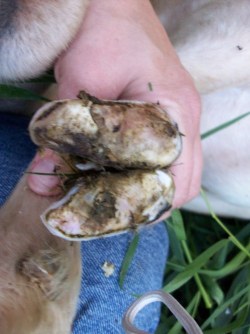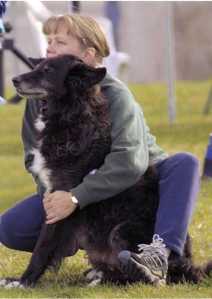Our house is on a bench on a hillside, and it overlooks all of our pasture. The pasture itself is in the 100-year floodplain (the house is not). Though many people think that term means that the area floods once in one hundred years; the actual definition is that any given year, it has a 1% chance of flooding. That’s a little different! 🙂
The valley where our pasture lies is very rich and fertile bottom land that holds water all summer, thus it’s highly desirable for farming and grazing. This area was homesteaded in the 1880’s, and at that time, neighboring farmers collaborated to clear and drain what was, then, a marshland. So, this entire valley is cut with a network of very deep drainage ditches. These carry excess water to the nearby river, and lower the water table in the fields so they are suitable for agriculture.
Since that time, these cooperating farmers also build a network of river dikes, in an attempt to tame nature and minimize semiannual flooding in the valley. In the early years of these tries, the diking sometimes made flooding affects worse. If the dikes are not of an even height across the entire valley, when the river does exceed one dike section’s height, the concentrated force of all that water flow will do severe damage to the dike in that section and anything close by.
So, over time, these farmers and dike owners created cooperative, government-overseen organizations to manage the dikes. The chief goal is to make the dikes a consistent height, and to keep them under vigilant maintenence. We pay special taxes to the local flood control district, and they provide us with the service of managing the floodway. This also includes regular dredging of the drainage ditches in ours and our neighbors’ fields.
In recent history, our pasture was under water once in the ’70s, twice in the ’90s, and again two years ago. The last flood was an “overtopping” where the dikes all held, and the water simply exceeded their height and gently flowed over the top. That year, our pasture was under about five feet of water for several days. These are the most desirable types of flood, very calm and following the engineering designs laid out for them. If any portion of a dike ever breaches, then the force of the water will destroy a section of the dike, and general damage is much worse. This was true in the three earlier floods, with the one in the ’70s being probably the most devastating to the region.
We are especially lucky because we have a pump station nearby. So, when it does flood, as soon as the river receeds, the pumps can be turned on, and all the water sent back where it came from. This reduces the wait time for the fields to dry out, from weeks or months down to a few days. So, it’s not a bad deal– we work around a few floods, and in turn, we have some very rich agricultural land and much natural beauty that will never be filled with housing developments.
 These days, working around the floods is actually not too inconvenient. Now we have water height and flow guages in many places along all rivers, and this data is automatically published to the Internet via various monitoring websites, most of it real-time. The graph to the left is the guage for the pump station near us. The National Weather Service monitors all of these guages and uses sophisticated computer modeling systems to predict and warn of potential flooding. Obviously, when major rains or snow melt are predicted, we know to start watching these guages!
These days, working around the floods is actually not too inconvenient. Now we have water height and flow guages in many places along all rivers, and this data is automatically published to the Internet via various monitoring websites, most of it real-time. The graph to the left is the guage for the pump station near us. The National Weather Service monitors all of these guages and uses sophisticated computer modeling systems to predict and warn of potential flooding. Obviously, when major rains or snow melt are predicted, we know to start watching these guages!
Friday was one of those days: we’d had several days of rain already, and more predicted to be on the way. I started checking the guages a few times a day earlier in the week, and when the graph starts going up, I started checking them once an hour.
This is the first year where it really mattered, since we now have livestock down there. And, of course, I’d procrastinated a little bit on being truly ready. I had enough hog panels to make a pen “up top”, but they were still down in the pasture with the sheep, where I had fashioned a temporary pen for the ram. It was on my to-do list to bring those up to the house and get the pen ready, but we’d just been so busy with other things! And, I knew I’d have some time to react if it started raining.
I went to work Friday, but by noon, I could see the guage shooting upward at a pretty steep slope. If it kept on at that rate, it would flood around midnight that night. So, I headed home early. It took a couple of hours to dismantle the pen, bring it up, and rebuild it. I kept watching the graph, but by 2pm, it was not cresting. So, it was clear, the animals had to come up before dark. My dad and Kirk stayed up top near the pen, to help if needed. I took Maggie down the the field to round up the sheep.
The path the sheep needed to take was on the vacant neighboring property, across a culvert, and up a steep embankment. None of this is fenced, so it is essential to have a fast dog to help, or I could lose the sheep and not be able to run fast enough to stop them. I already knew the sheep would go ok, they are pretty calm and have been worked a little by the dogs. But, the llama was another story, I really didn’t know what to expect, and knew we might have to get creative!
The sheep were very reluctant to go through the gate, they are always fearful of new places. I got them through once, and left the llama behind, but I didn’t latch it properly, and they ended up spooking and pushing their way back through it. The second attempt left two sheep behind– #33 and her lamb, along with the llama (#33 seems to really like the llama…). So, fine, I brought the five of them up, it was a little bumpy, but we did it, and with only a small amount of messing around, got them into the pen. It did help to have my dad and Kirk there, though I think now that I’ve done it once, I’d be confident enough to do it alone with the dog. When I went back for the other two, that was easy too. #33 comes to me when a dog is present, so I just put a lead rope on her, knowing her lamb would follow. But, the llama… I got to the gate, took the sheep through, and tried to open it a crack to tempt the llama so I could grab her halter. Not happening. She would not come close enough.
But, by this time, I could see she was distressed. She did NOT want to be left behind from those sheep! She was making her funny llama sound, a sort of quiet, buzzing cry. She sounded very pathetic and she looked very concerned and torn. It is amazing how much she has bonded to them in such a short time. It became obvious that she would stay with those sheep no matter what. So, I figured, what the heck, even if I can’t catch her or get her in the pen, fine, I know she’ll stand right outside it all night. So, I just opened up the gate and had a loose llama free to roam the valley! 🙂
It felt a little risky, but I was right, she stuck to those sheep like glue. Once up top, I shoved the two sheep in the pen, had the dog hold them all to the back of the pen, and then opened the gate back up for the llama. She was very cautious, but it was easy to slowly edge her in. And that was that! They were penned in a small, 10×20 area for the night.
I figured the river wouldn’t actually flood, so I decided to wait and see. In the morning, I’d either have to buy some hay and set them up with water to wait out a real flood, or the river would have crested and they could go back down. The latter was true. As you can see by the graph, the river crested late at night and was well on its way back down by morning. So, I had Gene help me take them back down. Same thing this time, I just concentrated on moving the sheep where I wanted them, and the llama went right along. They were happy to be back in their graze and comfort zone. And, we’re done with the flood plain fire drill until next time!






